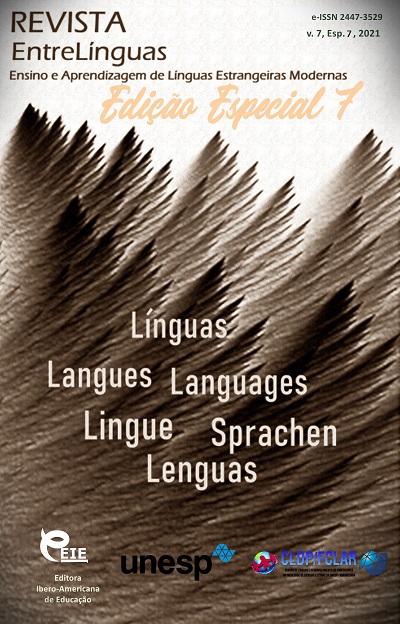A vida vegetal na cosmovisão onomástica dos tártaros
DOI:
https://doi.org/10.29051/el.v7iesp.7.16331Palavras-chave:
Língua tártara, Onomística, Linguoculturologia, Etnocultura, FitonimiaResumo
A cosmovisão onomástica reflete os aspectos mais importantes da cultura e da história, visão de mundo e psicologia das pessoas. O significado de algumas unidades onomásticas contém camadas informativas ocultas do pensamento mitológico arcaico. Um dos grupos mais significativos entre essas unidades inclui nomes do mundo vegetal. O objetivo deste artigo é demonstrar a especificidade da representação da vida vegetal na visão de mundo onomástica dos tártaros. A análise envolve a interpretação do significado dos topônimos e antropônimos, retendo repercussões das crenças dos antigos turcos. A análise foi realizada em material linguístico e cultural por meio de um complexo de métodos e técnicas interdisciplinares. A análise conduzida revelou que a tradição de usar nomes de flora como nomes próprios remonta às formas arcaicas da mitologia, que concebiam uma árvore como o símbolo do deus supremo. As antigas visões ingênuas dos turcos foram transmitidas à moderna onomástica dos tártaros. Devido à sua estabilidade, o sistema toponímico retém as primeiras visualizações. No sistema antroponímico, apesar do fato de que muitos dos antropônimos antigos perderam o uso, as tradições e os motivos de nomeação continuaram ao se emprestar antropônimos de outras línguas
Downloads
Referências
(1969). Ancient Turkic Dictionary. Leningrad, 676 p.
(1993). “Dialect Dictionary of the Tatar Language” (in Tatar), 789 p.
BLAGOVA, G. Anthroponymic System as Projection of Cosmological and Social Views of the Ancient Turks. Comparative-historical Grammar Book of the Turkic Languages. The Ancient Turkic Proto-Language. The Worldview of the Ancient Turkic Ethnos by the Language Data”, Moscow, 660–754. 2006.
GALIULLINA, G., YUSUPOVA, A., KHADIEVA, G., & DENMUKHAMETOVA, E. Turko-Tatar Vocabulary as Cognitive Mapping of the National Mentality. Kazan, 120 p. 2001.
ISAEV, Y. Phytonymic Conceptuary as Dictionary of a New Type (a case study of the Chuvash and Tatar Languages. Cheboksary, 191 p. 2013.
ISMAGILOVA, A., GALIULLINA, G., & KUZMINA, KH. Functional potential of mother tongue in conditions of bilingualism among youth of the Republic of Tatarstan. Modern Journal of Language Teaching Methods, 66–70. 2016.
Kamilovna Khadieva, G., Raisovna Galiullina, G., Khatipovna Kuzmina, K., & Airatovna ABDRAKHMANOVA, A. Metaphoric Terms in Tatar Toponyms as the Reflection of the National World-View. Research in Applied Linguistics, 10(Proceedings of the 6th International Conference on Applied Linguistics Issues (ALI 2019) July 19-20, 2019, Saint Petersburg, Russia), 802-808. 2019.
Khatipovna Kuzmina, K., Kamilovna Khadieva, G., Raisovna Galiullina, G., & Ramilevna AKHUNZHYANOVA, D. The History of the Development of Literary Tatar Language in the 20th Century (Based on the Example of the Language of Literary Works). Research in Applied Linguistics, 10(Proceedings of the 6th International Conference on Applied Linguistics Issues (ALI 2019) July 19-20, 2019, Saint Petersburg, Russia), 847-854. 2019.
KHVOLSEN, D. News on the Khazars, the Burtas, the Bulgars, the Magyars, the Slavs, and the Rus by Abu-Ali Ben-Omar Ibn-Dast. Saint-Petersburg. 1869.
KOVALEVSKIY, A. Book by Akhmed Ibn Fadlan on his Journey to the Volga in 921-922. Khar’kov, 345 p. 1956.
MUKHAMETOVA, I. I., KADIROVA, E. K., YUSUPOV, A. F., & ALKAYA, E. SOMATISMS IN THE OLD TATAR LANGUAGE. Revista TURISMO: Estudos e Práticas, 1, 1-5. 2019.
SATTAROV, G. Anthroponyms of the Tatar Autonomous Soviet Socialist Republic. (in Tatar), Kazan, 296 p. 1973.
SUPERANSKAYA, A., STALTMANE, V., PODOLSKAYA, N., & SULTANOV, A. Theory and Methods of Onomastic Research. Moscow, 254 p. 2007.
YERBULATOVA, I., KIRILLOVA, Z., & SAHIN, L. National and Cultural Realias of Translations into Tatar. Humanities and Social Sciences Reviews, 7(6), 984–987. 2019.
YUSUPOVA, A. S., GALIULLINA, G. R., & DENMUKHAMETOVA, E. N. Representation of national mentality in Turkic-Tatar vocabulary. Life Sci J, 11(7), 506-508. 2014.
Downloads
Publicado
Como Citar
Edição
Seção
Licença

Este trabalho está licenciado sob uma licença Creative Commons Attribution-NonCommercial-ShareAlike 4.0 International License.
Os manuscritos aceitos e publicados são de propriedade da Revista EntreLínguas. Os artigos publicados e as referências citadas na Revista EntreLínguas são de inteira responsabilidade de seus autores.
Transferência de direitos autorais – autorização para publicação
Caso o artigo submetido seja aprovado para publicação, já fica acordado que o(s) autor(es) autoriza(m) a UNESP a reproduzi-lo e publicá-lo na EntreLínguas, entendendo-se os termos “reprodução” e “publicação” conforme definição respectivamente dos incisos VI e I do artigo 5° da Lei 9610/98. O artigo poderá ser acessado pela rede mundial de computadores (Internet), sendo permitidas, a título gratuito, a consulta e a reprodução de exemplar do artigo para uso próprio de quem a consulta, desde que haja a citação ao texto consultado. Essa autorização de publicação 328 EntreLínguas, Araraquara, v. 1, n .2, p. 323-328, jul./dez. 2015 não tem limitação de tempo, ficando a UNESP responsável pela manutenção da identificação do(s) autor(es) do artigo. Os artigos publicados e as referências citadas na Revista EntreLínguas são de inteira responsabilidade de seus autores.











